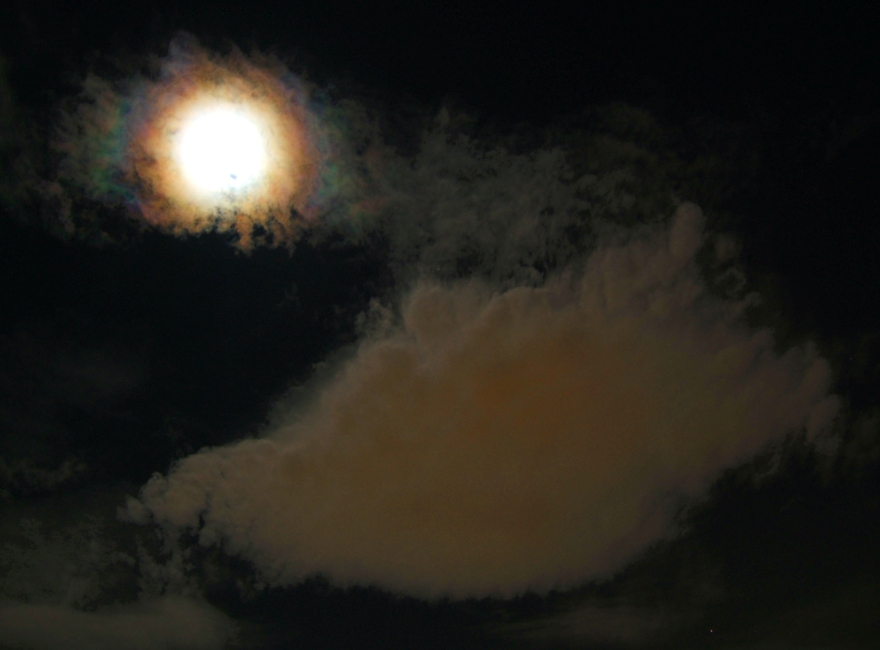Difference between revisions of "LPOD Jan 25, 2008"
(Created page with "<div id="content_view" class="wiki" style="display: block"> =SKY PAINTING= MoonCoronaForPanagiotis.jpg<br /> ''image by:'' someone who...") |
|||
| Line 1: | Line 1: | ||
<div id="content_view" class="wiki" style="display: block"> | <div id="content_view" class="wiki" style="display: block"> | ||
=SKY PAINTING= | =SKY PAINTING= | ||
| − | [[Image:MoonCoronaForPanagiotis.jpg|MoonCoronaForPanagiotis.jpg]]<br /> ''image by:'' someone who truly loves his wife and son!<br /> <br /> What do you think every time you see a cloudy sky? Not pleasant thoughts I guess. Another lost opportunity to admire the heavens or to shoot some marvelous Moon close ups with the 18″ Reflector (I wish I had one!). This beautiful [http://www.lpod.org/?p=826 Moon Corona] proves that even in a cloudy sky, our favorite celestial body can produce marvelous scenes. Since this image is not evaluated and selected by Chuck, allow me not to reveal my name. I don’t want to take credit for choosing myself for LPOD! I can only give you two or three clues for myself: I’m from Greece, I DON’T like garlic and I do love my wife and my son with all my heart! The image is dedicated to my son Panagiotis.<br /> <br /> And some info about coronas from the [http://en.wikipedia.org/wiki/Corona_%28meteorology%29 Wikipedia]: A corona is produced by the diffraction of light from either the Sun or the Moon by individual small water droplets (and sometimes tiny ice crystals) of a cloud. The corona consists of small number of concentric colored rings around the celestial object and a central bright aureole. The angular size of the corona depends on the diameters of the cloud droplets - small droplets produce bright coronae. Coronae differ from [/LPOD%20Jan%2018%2C%202008 haloes] in that the latter are formed by refraction from comparatively large rather than small ice crystals.<br /> <br /> ''Editor's note: Chuck Wood is on vacation. Today's LPOD has been contributed by a member of the-Moon Wiki. You can [/How%20to%20Create%20an%20LPOD%20Page do the same] while we await Chuck's return.''<br /> <br /> '''Technical Details'''<br /> <br /> '''Related Links'''<br /> [http:// | + | [[Image:MoonCoronaForPanagiotis.jpg|MoonCoronaForPanagiotis.jpg]]<br /> ''image by:'' someone who truly loves his wife and son!<br /> <br /> What do you think every time you see a cloudy sky? Not pleasant thoughts I guess. Another lost opportunity to admire the heavens or to shoot some marvelous Moon close ups with the 18″ Reflector (I wish I had one!). This beautiful [http://www.lpod.org/?p=826 Moon Corona] proves that even in a cloudy sky, our favorite celestial body can produce marvelous scenes. Since this image is not evaluated and selected by Chuck, allow me not to reveal my name. I don’t want to take credit for choosing myself for LPOD! I can only give you two or three clues for myself: I’m from Greece, I DON’T like garlic and I do love my wife and my son with all my heart! The image is dedicated to my son Panagiotis.<br /> <br /> And some info about coronas from the [http://en.wikipedia.org/wiki/Corona_%28meteorology%29 Wikipedia]: A corona is produced by the diffraction of light from either the Sun or the Moon by individual small water droplets (and sometimes tiny ice crystals) of a cloud. The corona consists of small number of concentric colored rings around the celestial object and a central bright aureole. The angular size of the corona depends on the diameters of the cloud droplets - small droplets produce bright coronae. Coronae differ from [/LPOD%20Jan%2018%2C%202008 haloes] in that the latter are formed by refraction from comparatively large rather than small ice crystals.<br /> <br /> ''Editor's note: Chuck Wood is on vacation. Today's LPOD has been contributed by a member of the-Moon Wiki. You can [/How%20to%20Create%20an%20LPOD%20Page do the same] while we await Chuck's return.''<br /> <br /> '''Technical Details'''<br /> <br /> '''Related Links'''<br /> [http://www2.lpod.org/wiki/June_3,_2004 Lunar Ring] [http://www.lpod.org/?p=826 More Rings Around the Moon]<br /> <br /> [/LPOD%20Index Index] of past LPOD's<br /> <br /> <br /> <br /> </div> |
Revision as of 18:00, 11 April 2018
SKY PAINTING

image by: someone who truly loves his wife and son!
What do you think every time you see a cloudy sky? Not pleasant thoughts I guess. Another lost opportunity to admire the heavens or to shoot some marvelous Moon close ups with the 18″ Reflector (I wish I had one!). This beautiful Moon Corona proves that even in a cloudy sky, our favorite celestial body can produce marvelous scenes. Since this image is not evaluated and selected by Chuck, allow me not to reveal my name. I don’t want to take credit for choosing myself for LPOD! I can only give you two or three clues for myself: I’m from Greece, I DON’T like garlic and I do love my wife and my son with all my heart! The image is dedicated to my son Panagiotis.
And some info about coronas from the Wikipedia: A corona is produced by the diffraction of light from either the Sun or the Moon by individual small water droplets (and sometimes tiny ice crystals) of a cloud. The corona consists of small number of concentric colored rings around the celestial object and a central bright aureole. The angular size of the corona depends on the diameters of the cloud droplets - small droplets produce bright coronae. Coronae differ from [/LPOD%20Jan%2018%2C%202008 haloes] in that the latter are formed by refraction from comparatively large rather than small ice crystals.
Editor's note: Chuck Wood is on vacation. Today's LPOD has been contributed by a member of the-Moon Wiki. You can [/How%20to%20Create%20an%20LPOD%20Page do the same] while we await Chuck's return.
Technical Details
Related Links
Lunar Ring More Rings Around the Moon
[/LPOD%20Index Index] of past LPOD's